Are your online marketing efforts falling short of your expectations? Are you struggling to convert visitors into customers or leads? If so, you’re not alone. Many businesses face the same challenge, and the solution might be simpler than you think. In this blog, we’re about to unravel the secrets of boosting your conversion rates by creating stunning landing pages with Elementor, a powerful and user-friendly page builder plugin for WordPress.
A captivating and well-optimized landing page can be the difference between a visitor clicking away or becoming a loyal customer. Elementor is a game-changing tool that empowers you to design landing pages that not only look stunning but also drive results. From eye-catching visuals to persuasive content, Elementor offers an array of features and customization options to craft landing pages tailored to your specific goals.
We’ll walk you through the step-by-step process of creating landing pages with Elementor that not only grab attention but also guide your visitors towards taking the desired action. Whether you’re looking to boost e-commerce sales, generate leads, or promote your services, Elementor can help you achieve your conversion goals.
So, if you’re ready to supercharge your online presence and skyrocket your conversion rates, stay with us as we dive into the world of Elementor and show you how to create landing pages that leave a lasting impact. Your digital success story begins here!
What Is A Landing Page?
A landing page is a crucial element in the realm of digital marketing and online advertising. It is a standalone web page, distinct from your main website, created for a specific purpose—typically, to convert visitors into leads or customers. Landing pages are designed with a singular focus, guiding visitors to take a specific action, such as signing up for a newsletter, making a purchase, or filling out a contact form. These pages are a powerful tool for marketers, as they enable precise targeting and a streamlined user experiences.
Landing pages are intentionally stripped of distractions. Unlike regular website pages, they lack navigation menus, links to other pages, and often limit the content to the essentials. The absence of these distractions ensures that visitors are less likely to wander away from the intended action.
A well-optimized landing page should have a compelling headline, engaging visuals, persuasive content, and a clear call to action (CTA). It’s also common to include social proof, testimonials, or trust badges to build credibility and trust. In essence, landing pages are a conversion-focused component of your digital marketing strategy.
What Sets A Landing Page Apart From A Website?
While both landing pages and websites exist on the internet, they serve fundamentally different purposes and exhibit distinct characteristics.
- Purpose and Focus: The primary distinction between a website and a landing page is their purpose and focus. A website serves as your online hub, providing information about your business, products, services, and more. It’s a comprehensive representation of your brand. In contrast, a landing page is a standalone page designed for a specific marketing campaign with a laser-like focus on a single goal, like lead generation or sales.
- Content Depth: Websites are content-rich and often consist of multiple pages, setting home page in WordPress, about pages, product/service pages, blog posts, and contact pages. They provide in-depth information and resources for visitors to explore. Landing pages, on the other hand, are concise and usually limited to a single page. They are designed to deliver key information quickly and encourage immediate action.
- Navigation: Websites typically have navigation menus, allowing visitors to explore different sections of the site. In contrast, landing pages intentionally lack navigation menus to eliminate distractions and keep visitors focused on the CTA.
- Design and Layout: Landing pages are designed to be visually striking and compelling. They often have a cleaner and more direct layout to draw attention to the CTA. Websites have a broader design approach, accommodating various types of content and information.
- Target Audience: Websites cater to a wide range of audiences, including existing customers, potential leads, and those seeking information. Landing pages, in contrast, are specifically created for a select audience, often based on a marketing campaign or target demographic.
- Conversion Goals: Landing pages are primarily focused on conversion goals, such as getting visitors to complete a form, make a purchase, or download a resource. Websites also have conversion goals but are more versatile, serving various purposes, including providing information and building brand awareness.
- Analytics and Tracking: Tracking and analyzing user behavior on landing pages are typically more straightforward, as there are fewer distractions and fewer pages to navigate. Websites can be more complex to analyze due to the wide array of content and user interactions.
Overall, a landing page is a specialized, single-purpose web page designed to drive conversions, while a website is a broader digital platform that provides a comprehensive representation of your brand, products, and services. The choice between using a landing page or a website depends on your marketing objectives and the specific needs of your campaigns. Both are valuable components of a well-rounded digital marketing strategy.
Landing Pages Usually Consist Of The Following Key Elements:
When crafting a landing page, regardless of its purpose – be it lead generation, product sales, service promotion, or any other specific objective – there are several essential elements that play a pivotal role in its effectiveness.
- Headline: The headline serves as the initial point of contact between the visitor and the landing page. Its importance cannot be overstated. A compelling and attention-grabbing headline is the gateway to capturing the visitor’s interest. It should succinctly convey the core message and the value proposition that the page offers. A well-crafted headline entices the visitor to explore further.
- Content: Landing page content is distinct from what you’d typically find on a traditional website page. It’s intentionally concise, highly focused, and crafted with persuasion in mind. The content should revolve around the product or service being offered, outlining its benefits and providing compelling reasons why the visitor should take the desired action. The content’s role is to inform, persuade, and guide the visitor toward making a decision.
- Visuals: In the world of digital marketing, visuals are worth a thousand words. High-quality images, videos, and graphics significantly enhance the landing page’s visual appeal and help convey the intended message effectively. These elements are carefully chosen to complement the content and engage the visitor on a visual and emotional level. A well-designed landing page combines striking visuals with compelling content for a powerful impact.
- Call to Action (CTA): The call to action, often represented by a button or link, is the heart and soul of a landing page. This is where the visitor is directed to perform the desired action, whether it’s making a purchase, signing up for a newsletter, or requesting a quote. The CTA should be prominently placed, highly visible, and use persuasive language that leaves no ambiguity about what the visitor should do next. In order to increase conversions, CTAs must be effective.
- Form: If the primary goal of your landing page is lead generation, a form is an indispensable component. This form allows visitors to input their information in exchange for something valuable, such as an eBook, a whitepaper, or access to exclusive content. The form captures critical data that can be used for future marketing efforts, nurturing leads, and building relationships with potential customers. When implementing a form, keep it simple, requesting only the necessary information to encourage participation.
- Social Proof: Trust is a fundamental element in the decision-making process of any visitor. Testimonials, reviews, or trust symbols are strategically placed on a landing page to build credibility and trust. Positive feedback from previous customers or endorsements from reputable sources can reassure potential customers that they are making the right choice. Social proof serves as a validation of the product or service’s quality and reliability.
These fundamental elements collectively shape the character and functionality of a landing page. Each element contributes to the overall user experience and the page’s ability to guide visitors towards the desired outcome, making landing pages a crucial tool in the realm of online marketing and conversions.
How To Create Landing Pages With Elementor?
Creating landing pages with Elementor a straightforward process that empowers you to design highly customizable, visually appealing, and conversion-focused pages. As we know, Elementor is a popular WordPress page builder plugin that makes it easy for users with little to no coding experience to create professional landing pages. Here’s a step-by-step guide on how to create landing pages with Elementor website builder for WordPress.
Step 1: Install And Activate Elementor
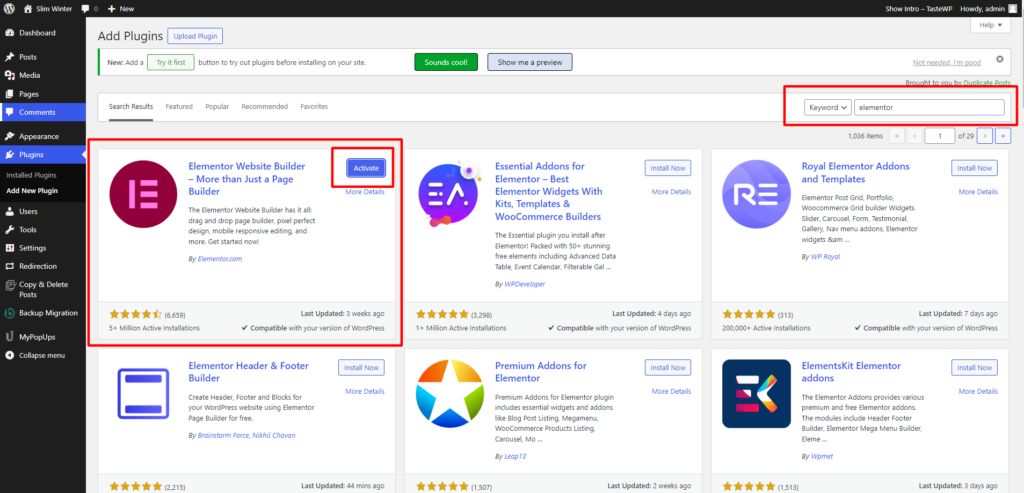
The first step in creating landing pages with Elementor is to install and activate the Elementor plugin. Before you embark on this journey, it’s crucial to ensure that you already have a WordPress website set up. If you don’t have a WordPress website, you can easily create one through a web hosting provider. WordPress provides a user-friendly platform for website creation and management, making it an excellent choice for building your online presence.
Once you have your WordPress website ready, it’s time to bring Elementor into the mix. In order to do this, visit your WordPress dashboard. On the left sidebar, you’ll find a “Plugins” tab. Click on it to access the plugins section. From there, click on “Add New” to explore and add new plugins to your website.
Simply type “Elementor” into the search bar and press enter. In the search results, you can see the Elementor plugin. Click “Install” to initiate the installation process. After the installation is complete, click “Activate” to activate the Elementor plugin on your WordPress website.
While Elementor offers a free version that is perfectly capable of creating basic landing pages, you can also consider upgrading to its pro version. The pro version provides more customization options, advanced widgets, and access to a library of pre-made landing page WordPress Elementor themes. To unlock these features, you’ll need to purchase the Elementor Pro license, which costs approximately $59/year for a single site. It’s highly recommended if you’re looking to take your landing page creation to the next level, providing you with additional tools to create even more stunning and effective landing pages. After purchasing, upload and activate the Elementor Pro plugin to leverage these premium features for your landing page projects.
Step 2: Create A New Page
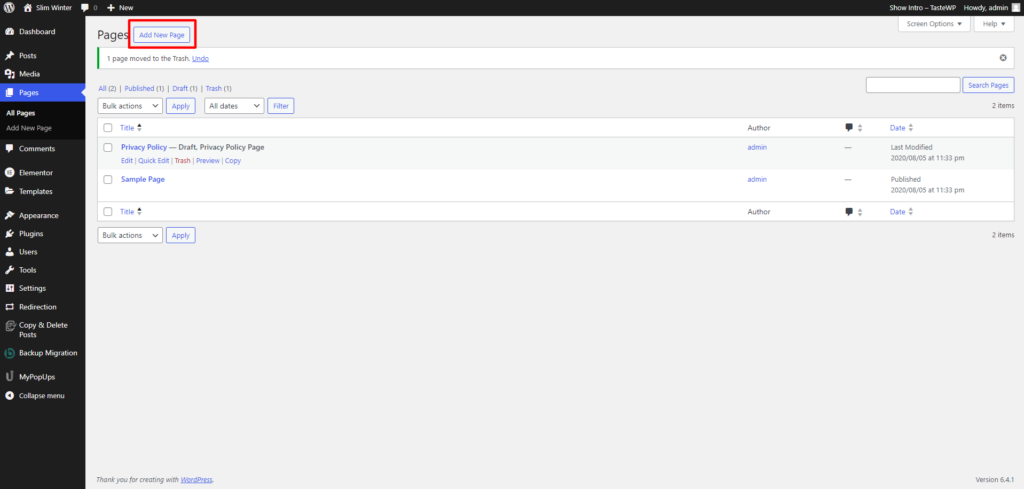
Once you’ve successfully activated the Elementor plugin, both the free and pro versions, the second step in creating landing pages with Elementor is to initiate the process by creating a new page in your WordPress dashboard. To do this, navigate to the “Pages” tab on the left-hand sidebar and select “Add New.” This action will open a blank canvas where your landing page will come to life. Here, you’ll begin crafting the visual and informational aspects of your landing page, tailoring it to your specific goals.
To further streamline your landing page creation process, it’s essential to give your new page a title that aptly reflects its intended purpose. This title will not only help you stay organized but will also serve as a brief identifier for your landing page within your WordPress dashboard.
Once your new page is created and titled, you’ll notice two distinct editing options. One is “Edit with Elementor,” and the other is “Edit with WordPress Editor.” To enter the realm of Elementor’s powerful page-building capabilities, you should click on “Edit with Elementor.” This action will seamlessly transition you into Elementor’s intuitive drag-and-drop interface, allowing you to begin the creative journey of designing your landing page with ease.
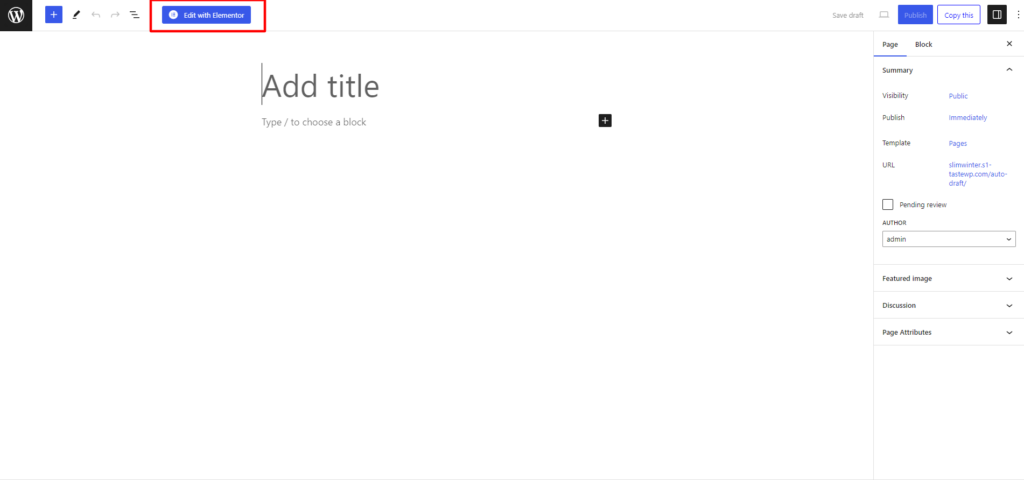
Step 3: Choose A Template (Optional)

One of the user-friendly features when creating landing page with Elementor is the option to choose from a variety of pre-designed templates. This step is entirely optional but can significantly expedite the landing page creation process.
Elementor’s template library is easily accessible by clicking on the folder icon within the Elementor interface. Once you click on it, you’re presented with a range of professionally crafted templates suitable for various purposes. At any given time, you may find approximately seven templates available, and these are designed to cater to different needs.
These templates cover a diverse spectrum of purposes, including digital courses, construction projects, services, webinars, podcasting, and luxury cars. When one of these templates aligns with your objectives, you can select it and proceed to customize it according to your brand and content requirements. Moreover you can also go for the WordPress theme bundle instead if you are a regular buyer of themes, by purchasing the WordPress theme bundle you can save yourself a couple of bucks.
By choosing a template, you’re essentially adopting a pre-designed structure and layout that’s been optimized for conversions. It offers you a head start, saving you the time and effort required to build a landing page from scratch. After selecting the template, you can simply click “Insert,” and the template is loaded onto your canvas. From there, you have the flexibility to change and personalize the content to your liking, ensuring it aligns perfectly with your unique message and brand identity.
Customization is a breeze with Elementor. You can modify the template’s content, images, text, colors, and other design elements to align with your brand and objectives. The templates serve as a foundational structure, saving you time and effort while offering the flexibility to create a landing page that is uniquely yours. It’s an excellent starting point, enabling you to maintain a professional and cohesive design while adapting it to your specific requirements. This feature makes Elementor a versatile and user-friendly tool for crafting landing pages.
Step 4: Customize Your Landing Page
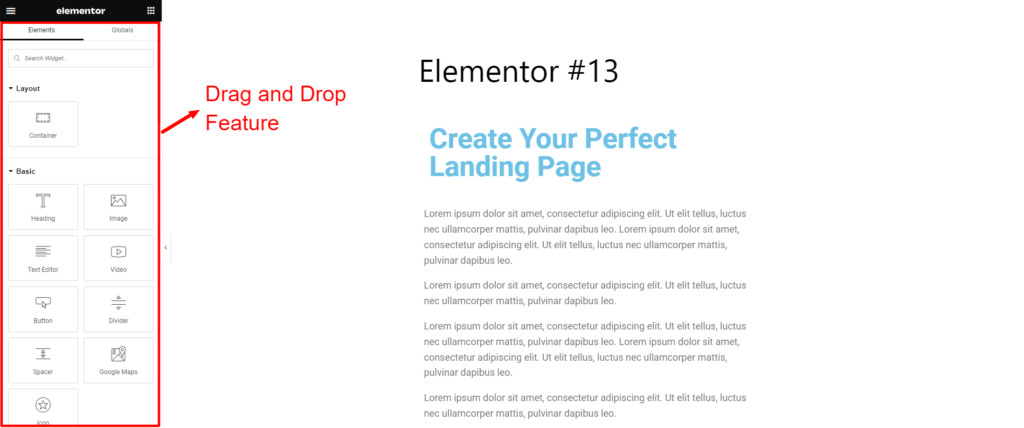
Customizing your landing pages with Elementor is where you transform a template or a blank canvas into a visually captivating and conversion-focused masterpiece. Elementor’s drag-and-drop interface is your creative playground, allowing you to effortlessly craft a page that aligns perfectly with your brand and campaign goals.
One of the first steps in customization is adding elements. With the simple click of the “+” button, you can introduce vital components to your page. These elements encompass headings, text blocks, images, buttons, forms, and more. A straightforward drag-and-drop action lets you position these elements exactly where you want them on your canvas.
Text and media are pivotal aspects of your landing page’s appeal. Elementor makes it a breeze to edit them. A simple click on any element allows you to tweak its text, swap images, and enhance other media. Fine-tuning fonts, colors, and styles ensures that your landing page harmonizes seamlessly with your brand identity.
The layout and structure of your landing page are fundamental to its effectiveness. Elementor grants you precise control over these elements. You can effortlessly adjust the layout by dragging and dropping sections, columns, and widgets. This flexibility empowers you to create the exact design that meets your unique requirements.
Adding widgets and elements to your page enhances its functionality and appeal. Elementor’s Elements panel provides access to an extensive array of widgets, including contact forms, countdown timers, social media icons, and much more. Simply drag these elements onto your canvas and configure them to align with your campaign objectives.
For those seeking advanced customization, Elementor offers a treasure trove of features. You can delve into custom CSS, implement eye-catching animations, and set conditional logic to create dynamic, interactive elements that leave a lasting impression on your visitors.
Elementor understands the importance of mobile responsiveness. Your landing page is mobile-friendly by default, but it’s essential to fine-tune it for different devices. You can effortlessly switch between desktop, tablet, and mobile views at the bottom of the Elementor interface. This ensures that your landing page looks and functions seamlessly across a variety of screen sizes, ensuring a superior user experience.
Step 5: Configure Page Settings
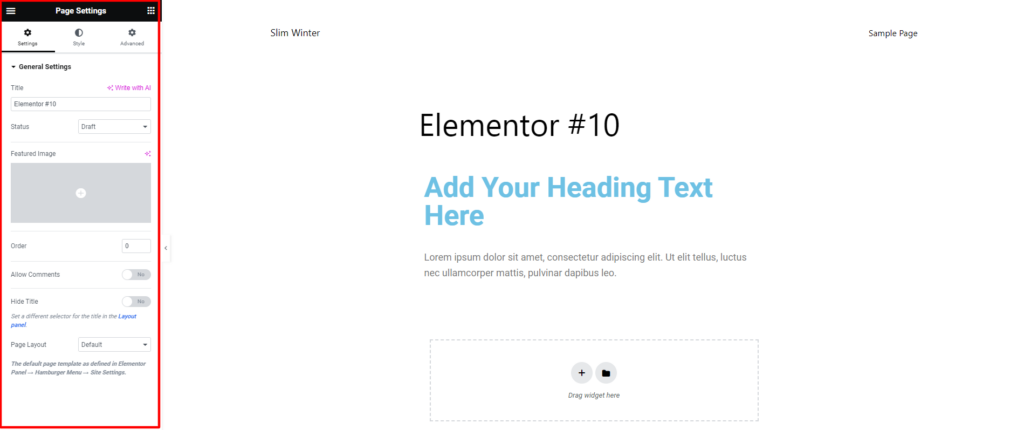
After you’ve designed your landing page content within Elementor, the next crucial step is configuring the page settings, located under the “Document” settings on the left sidebar. Here, you can fine-tune various page attributes.
Page Title: You can set the page title, which is essential for search engine optimization (SEO) and user understanding. Craft a title that’s descriptive, relevant to your landing page’s purpose, and engaging.
URL Slug: The URL slug is the part of the web address that identifies the specific page. It’s important for SEO and user-friendliness. You can customize the slug to make it concise and relevant to your content.
Page Title Display: Elementor allows you to control whether the page title is displayed on your landing page or hidden. This option is useful when your design doesn’t require the title to be visible.
Configuring these settings and essential addons for elementor ensures that your landing page is not only visually appealing but also optimized for SEO and user experience, making it more likely to attract and engage your target audience.
Step 6: Preview And Publish
Once you’ve meticulously designed your landing pages with Elementor, the next crucial step is to preview and publish it. This step ensures that your landing page is ready for public viewing and interaction. To do this, you’ll find two significant buttons at your disposal within the Elementor interface.
First, use the “Preview” button to get a firsthand look at how your landing page will appear to your website’s visitors. The preview function allows you to assess the design, layout, and functionality. This is your opportunity to catch any visual discrepancies or potential issues before making your landing page accessible to your audience.
Once you’ve thoroughly reviewed and are satisfied with the result, it’s time to take your landing page live. This can be done by clicking the “Publish” button present at the bottom of the left sidebar. By doing so, you make your landing page accessible to anyone who visits your website. This action officially integrates your newly created page into your site’s structure, and it becomes an integral part of your online presence, ready to fulfill its intended purpose, whether it’s generating leads, promoting products, or any other specific objective you’ve set for it.
Conclusion
In conclusion, we’ve explored the power of creating stunning landing pages with Elementor, understanding what distinguishes them from traditional websites and the essential elements that constitute these conversion-focused pages. We’ve also walked you through the six fundamental steps to craft your own captivating landing pages with this powerful WordPress plugins.
Landing pages with Elementor are a linchpin of successful online marketing campaigns, helping you channel your visitors’ attention and guide them towards specific actions, be it lead generation, sales, or any other objective. With Elementor’s user-friendly interface and an array of customizable elements, you have the tools at your disposal to create compelling landing pages that can significantly boost your conversion rates.
However, it’s important to note that if your web needs extend beyond single landing pages and encompass a full-fledged website with multiple pages and functionalities, you can explore Elementor WordPress themes like those provided by WPElemento. These themes are expertly optimized for seamless integration with Elementor, enabling you to effortlessly customize your entire website’s content without the need to delve into complex coding. This combination of Elementor and Elementor-optimized themes offers you a versatile and powerful toolkit for your online presence.





